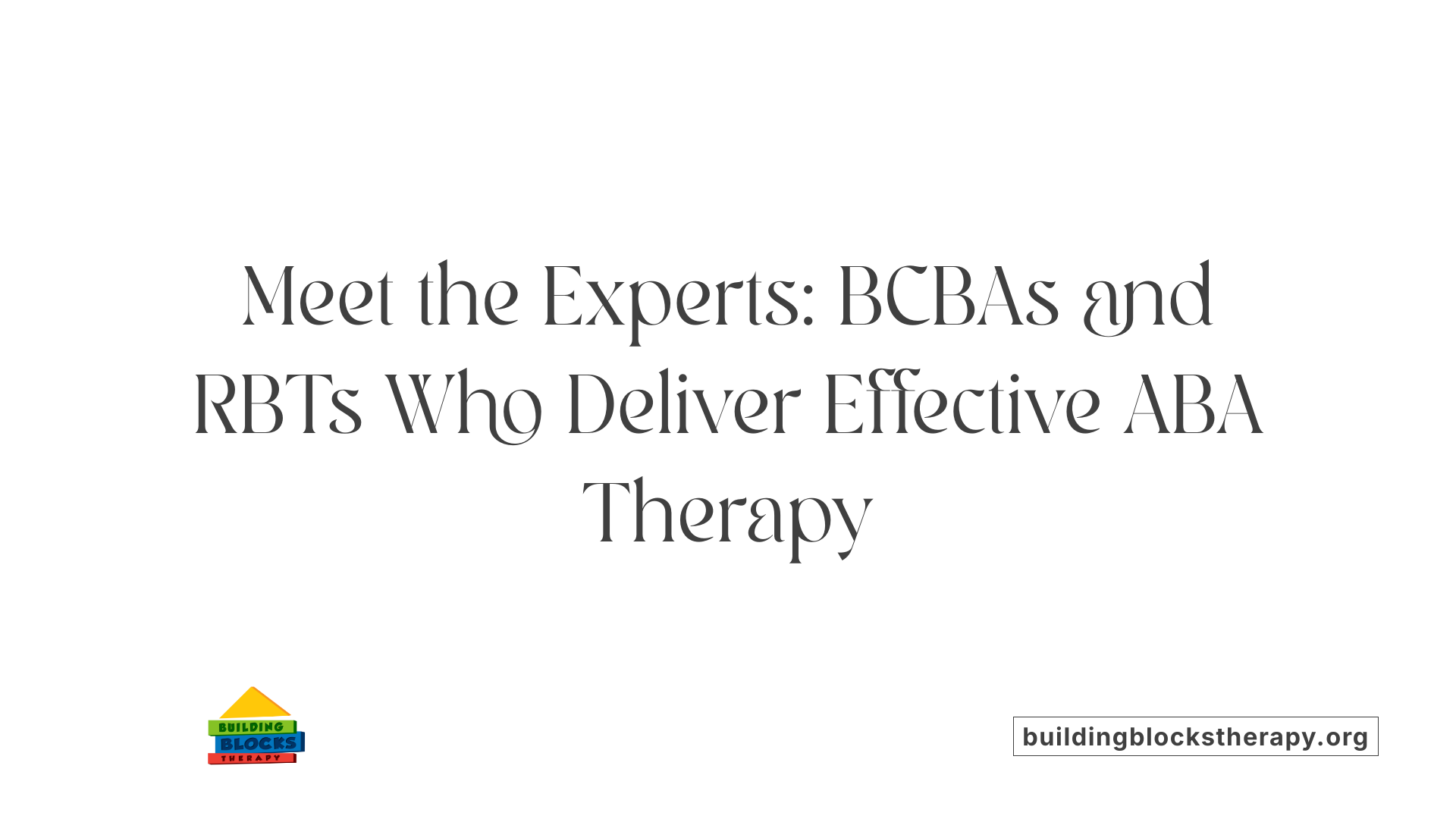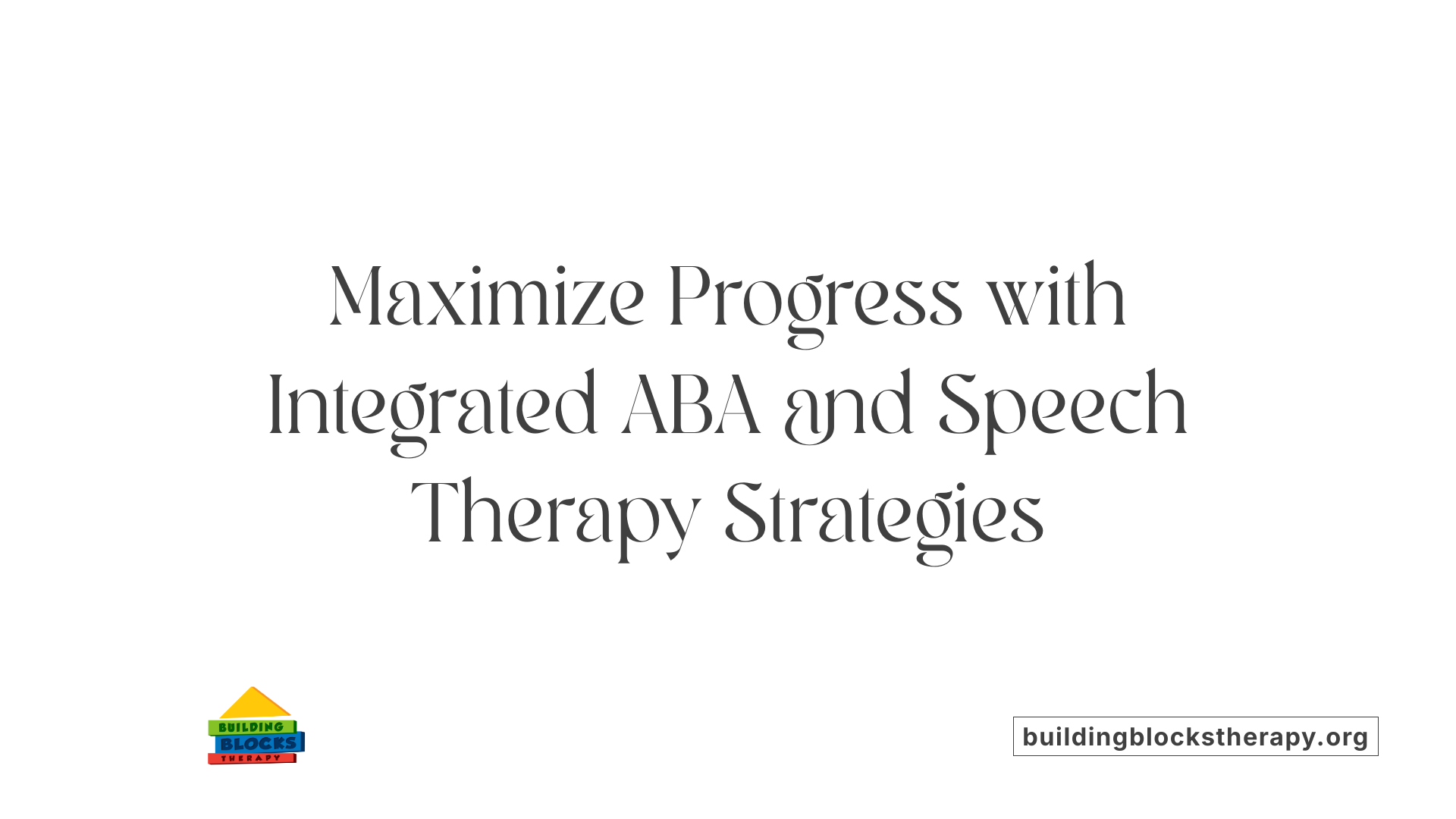Why Early Intervention Matters in Autism Therapy
Early speech and language therapy plays a crucial role in supporting children with autism spectrum disorder (ASD), particularly when integrated with Applied Behavior Analysis (ABA) therapy. By starting intervention at a young age, families can leverage the brain's neuroplasticity to foster communication, social skills, and behavioral improvements that lay a foundation for lifelong development. This article explores the benefits, methods, and evidence supporting early speech therapy in combination with ABA, emphasizing the importance of timely and tailored intervention.
The Science and Goals Behind Applied Behavior Analysis (ABA) Therapy
What is Applied Behavior Analysis (ABA) therapy, and how does it help individuals with autism?
Applied Behavior Analysis (ABA) therapy is a scientifically validated, evidence-based approach designed to understand how behavior works and how it is influenced by the environment. It focuses on increasing helpful behaviors and decreasing harmful or learning-impeding behaviors through structured, data-driven methods. ABA therapy is highly adaptable, with treatment plans uniquely tailored to each child's needs using assessments by Board Certified Behavior Analysts (BCBAs).
Behavioral principles underpinning ABA
ABA relies heavily on behavioral principles such as positive reinforcement—which rewards desirable behaviors to encourage their recurrence—and the A-B-C model (Antecedent-Behavior-Consequence), which analyses and modifies behavior by understanding its triggers and outcomes. Techniques like Discrete Trial Training, Functional Communication Training, and Natural Environment Teaching are used to build skills systematically. Verbal behavior theory also plays a role, categorizing language into operants like Mand (requests) and Tact (labels), which promotes varied communication abilities.
Goals of ABA including communication and social skills development
The overarching goals of ABA include enhancing language and communication skills, attention, social interaction, memory, academics, and reducing problematic behaviors. ABA helps children develop essential life skills such as dressing, eating, and hygiene, alongside improving social skills and emotional regulation. Early and intensive ABA therapy offers significant improvements in cognitive and adaptive behaviors and prepares children for real-world social interactions by teaching them to recognize social cues and manage behaviors.
Settings and adaptability of ABA therapy
ABA therapy is versatile and can be delivered across various settings including the home, school, and community. Therapy sessions are customized by qualified professionals, such as BCBAs and registered behavior technicians (RBTs), to meet individual needs. This flexibility ensures the therapy aligns with each child's environment and fosters skill generalization. ABA’s adaptability also allows integration with other interventions, supporting holistic development.
Who Provides ABA Therapy and Their Qualifications

Roles of Board Certified Behavior Analysts (BCBAs) and Registered Behavior Technicians (RBTs)
ABA therapy is primarily delivered by two types of professionals: Board Certified Behavior Analysts (BCBAs) and Registered Behavior Technicians (RBTs). BCBAs are licensed clinical experts responsible for designing, supervising, and evaluating individualized ABA treatment programs tailored to each child's unique needs. In contrast, RBTs work under BCBA supervision to implement the therapy on a day-to-day basis, directly engaging with children during sessions.
Educational and Certification Requirements
BCBAs must complete advanced education, typically a master's degree or higher in behavior analysis or a related field, meet specified supervised practical experience hours, and obtain certification through the Behavior Analyst Certification Board (BACB). RBTs, as paraprofessionals, complete targeted coursework and supervised clinical hours and receive certification demonstrating competency in delivering ABA interventions.
Work Settings and Collaboration with Families
These professionals provide ABA services across various environments including clinics, schools, hospitals, and home-based settings. Their roles emphasize collaboration with families to ensure consistent therapy implementation and to empower caregivers with strategies supporting the child's progress. Such teamwork enhances the effectiveness of the intervention and helps integrate learning into everyday life.
Together, BCBAs and RBTs form a comprehensive team with specialized training, ensuring ABA therapy is delivered effectively and tailored to support the developmental growth of children with autism.
Personalizing ABA Therapy: Meeting Each Child's Unique Needs
How is an ABA therapy program tailored to meet the unique needs of each individual?
An ABA therapy program begins with a thorough assessment process designed to understand a child's individual strengths, challenges, and areas for development. This assessment involves a combination of direct observations, caregiver interviews, and standardized tools to capture a comprehensive picture of the child's abilities and needs.
Based on this insight, therapists establish SMART (Specific, Measurable, Achievable, Relevant, Time-bound) goals that create focused, practical targets for progress. These goals guide the development of the individualized behavior plans, where specific interventions, prompts, and reinforcement methods are carefully selected to align with the child's preferences and learning style.
Throughout the therapy, systematic data collection plays a critical role. Therapists continuously track the child's responses to various interventions using detailed records, which helps identify what works best and where modifications are necessary. This data-driven approach ensures that the therapy remains flexible, allowing adjustments based on the child’s ongoing progress or emerging needs.
Personalization extends beyond just methodology—incorporating unique reinforcers tailored to the child's interests increases motivation and engagement. Scheduling is also adapted to the child's daily routine and family circumstances for maximum consistency and comfort.
Finally, collaboration with caregivers is essential for success. Caregivers receive training and guidance to reinforce skills outside therapy sessions, ensuring consistency in learning and behavior across environments. Open communication between therapists and families allows for shared decision-making and timely adjustments to the program, reinforcing a supportive network around the child.
This comprehensive and responsive approach ensures ABA therapy is not a one-size-fits-all solution but a carefully shaped intervention crafted to meet each child's unique developmental journey.
Core ABA Techniques Driving Behavioral and Communication Improvements

What are the common techniques or strategies used within ABA therapy to support behavioral change?
Applied Behavior Analysis (ABA) therapy employs several effective techniques to promote positive behaviors and communication skills in children with autism. A primary method is positive reinforcement, where desirable behaviors are rewarded to encourage repetition. For example, a child might receive praise or a small reward after successfully completing a task, increasing the likelihood of that behavior occurring again.
Another important strategy is prompting and fading, which involves initially providing support or cues to help a child perform a behavior and then gradually reducing assistance until the child can perform the behavior independently. This approach fosters skill acquisition while encouraging autonomy.
Discrete Trial Training (DTT) breaks down skills into small, structured steps and offers repeated practice opportunities. Each trial typically consists of a clear instruction, the child's response, and a consequence (like a reward), allowing for focused learning.
To teach multi-step tasks, behavior chaining is used. This process divides complex activities into sequential steps that are taught one by one, helping children master each component before linking them together.
Natural Environment Teaching (NET) emphasizes learning within everyday routines and settings. For instance, teaching communication or social skills during play or daily activities helps generalize learning to real-world contexts.
Visual supports like visual modeling and visual aids use pictures or videos to demonstrate behaviors or skills. These can enhance understanding, especially for children who benefit from visual learning.
Lastly, extinction involves reducing problematic behaviors by withholding reinforcement that previously maintained those behaviors, helping decrease their occurrence.
By combining these varied but complementary techniques, ABA therapy creates tailored interventions that effectively support behavioral change and foster communication development in children with autism.
Effectiveness of ABA Therapy: Evidence and Outcomes
What evidence supports the effectiveness of ABA therapy for individuals with autism?
Numerous scientific studies have consistently demonstrated ABA therapy's effectiveness in improving various developmental areas for children with autism spectrum disorder (ASD). Research shows that ABA leads to significant gains in social skills, communication, adaptive behaviors, and daily living skills.
One major strength of ABA is its evidence-based approach. Over 20 rigorous studies have validated ABA's efficacy, especially when intervention is early and intensive. Structured ABA programs, tailored by board-certified behavior analysts (BCBAs), focus on teaching useful behaviors while reducing problem behaviors.
How does ABA improve social skills and communication?
ABA therapy employs techniques such as Discrete Trial Training and Functional Communication Training that directly target social deficits common in autism. The therapy helps children understand social cues, improve eye contact, and engage more effectively with peers and adults.
Communication skills are also enhanced through verbal behavior interventions that teach children how to make requests, describe their surroundings, respond appropriately, and expand vocabulary. These improvements enable better social interaction and emotional regulation.
What adaptive behavior gains are observed with ABA therapy?
ABA supports development of daily living skills critical for independence, such as dressing, eating, and toileting. It also addresses behavioral challenges by applying the A-B-C (antecedent-behavior-consequence) analysis to reinforce positive behaviors and reduce maladaptive ones.
By improving attention, memory, and academic skills, ABA prepares children for more successful participation at home, school, and community settings.
Why is early and intensive ABA therapy important?
Early intervention leverages brain plasticity during childhood, when learning potential is at its peak. Children beginning ABA therapy before age five often experience more substantial benefits in cognitive and social domains.
Intensive ABA programs, typically delivered over 1–3 years, yield better outcomes because they provide consistent learning opportunities and adapt goals as the child grows. Early ABA combined with family involvement ensures skills are practiced and generalized beyond therapy sessions.
| Aspect | Description | Outcome Evidence |
|---|---|---|
| Social Skills | Teaching social cues, eye contact, interaction improvement | Significant gains in social engagement demonstrated |
| Communication | Verbal behavior focus, communication training techniques | Improved verbal and nonverbal communication skills |
| Adaptive Behaviors | Daily living skills and behavior management | Enhanced independence and reduced problem behaviors |
| Early & Intensive Therapy | Starting before age 5, consistent sessions | Stronger developmental gains across multiple areas |
Early Speech and Language Therapy: Foundations and Benefits

What is the role of speech therapy in ASD?
Speech therapy plays a vital role in addressing language and communication challenges faced by children with Autism Spectrum Disorder (ASD). It targets verbal, nonverbal, and social communication skills to improve overall interaction and comprehension. Therapists use various strategies, including articulation therapy, oral motor exercises, and augmentative and alternative communication (AAC) systems, which help children express themselves more effectively.
How does speech therapy improve communication?
Speech therapy supports children with ASD by enhancing their ability to communicate both verbally and nonverbally. It improves speech production, language comprehension, and social use of language. This leads to better social interaction skills, allowing children to engage more easily with peers and adults. Improvements in communication also contribute to academic success by facilitating clearer expression and understanding.
How is speech therapy integrated with ABA techniques?
Combining speech therapy with Applied Behavior Analysis (ABA) techniques can increase treatment effectiveness. ABA focuses on teaching communication through behavioral principles, such as reinforcement and structured learning sessions. Speech therapy complements this by targeting speech-specific skills, while ABA helps embed communication in functional, real-life settings. Collaboration between behavior analysts and speech-language pathologists ensures that goals align and therapies reinforce each other for more comprehensive development.
Why is early initiation of speech therapy important?
Starting speech therapy early, ideally in toddlers or preschool-aged children, takes advantage of the brain's neuroplasticity. Early intervention leads to significant gains in communication skills during critical developmental periods. Although improvements in speech and language might require sustained support, initiating therapy early sets a strong foundation for later language growth and social skills development, facilitating better overall outcomes for children with ASD.
Maximizing Outcomes Through Combined Early Intervention Approaches

Benefits of combining ABA and speech therapy
Combining Applied Behavior Analysis (ABA) and speech therapy can significantly enhance outcomes for children with autism. ABA therapy focuses on building social skills, reducing maladaptive behaviors, and increasing functional communication through behavioral techniques. Speech therapy directly targets communication by improving speech production, language comprehension, and social communication. Together, these therapies address complementary areas—behavioral and linguistic—that are often impaired in children with ASD, leading to improved communication abilities and better adaptive behaviors.
Collaborative treatment planning between professionals
Effective integration of ABA and speech therapy requires collaborative planning between board-certified behavior analysts (BCBAs) and speech-language pathologists (SLPs). By aligning goals and sharing assessment data, these professionals can design coherent intervention plans tailored to each child's unique needs. Collaboration ensures that behavioral strategies complement language objectives without redundancy or conflict, promoting a more streamlined and comprehensive therapeutic experience.
Enhanced gains in communication and behavior
Research shows that early intervention using both ABA and speech therapy results in superior improvements in communication skills, such as making requests (mands), describing the environment (tacts), and responding to questions (intraverbals). Furthermore, behavior challenges like repetitive behaviors and social deficits are reduced more effectively when the therapies are combined. This synergistic effect maximizes the child’s potential in social interaction, emotional regulation, and functional communication.
Importance of family involvement
Family participation is crucial across combined early intervention programs. Caregivers learn strategies to support their child’s progress in everyday environments, reinforcing therapy goals outside clinical settings. Involving families equips them with the understanding needed to respond to their child’s behaviors and communication efforts, fostering consistency and encouraging the child's development across home, school, and community contexts.
Critical Window for Early Intervention: Timing and Impact

Why is neuroplasticity important in early childhood intervention?
Early childhood is a period marked by high neuroplasticity—the brain's remarkable ability to reorganize and form new neural connections in response to learning and experience. This plasticity creates a vital opportunity for interventions to effectively shape developmental trajectories in children with autism spectrum disorder (ASD).
How does age affect responsiveness to autism therapies?
Research has revealed that children starting intervention between 36 and 47 months of age experience significantly greater reductions in autistic symptoms than those beginning between 48 and 60 months. Younger children show more marked improvements in repetitive behaviors, social interaction, and communication skills due to the heightened receptiveness of their developing brains.
What are pediatricians’ recommendations for autism screening?
The American Academy of Pediatrics recommends systematic autism screening at 18 and 24 months. Early and accurate identification made by pediatricians facilitates timely referrals for therapies such as Applied Behavior Analysis (ABA), which is critical to harnessing the optimal developmental window.
How does early intervention enhance social, emotional, and cognitive growth?
Beginning therapy at an earlier age enhances socio-emotional development, leading to improved emotional regulation and adaptive behaviors. These gains support better social participation and communication abilities, which are foundational for cognitive and academic success. Early intervention thus promotes a broad spectrum of developmental benefits beyond just symptom reduction.
| Aspect | Age Group Showing Greater Improvement | Impact Detail |
|---|---|---|
| Neuroplasticity | 0–5 years | Maximizes learning potential through brain adaptability |
| Autistic Symptom Reduction | 36–47 months | Greater decline in repetitive behaviors and social deficits |
| Screening Timeline | 18 & 24 months | Early detection enables timely, effective therapeutic engagement |
| Socio-Emotional Development | Younger children | Improved emotional regulation and adaptive skills |
Early intervention, especially in the critical window before age five, forms the cornerstone for effective autism therapies by capitalizing on neuroplasticity and supporting comprehensive developmental progress.
Early Speech and Language Therapy: A Catalyst for Lasting Development
Early speech and language therapy, especially when combined with ABA, offers transformative potential for children with autism. Starting interventions during the brain’s critical periods of development maximizes gains in communication, social interaction, and adaptive behaviors. Scientific evidence underscores the effectiveness of these therapies in improving quality of life and lifelong skills. Engaging qualified professionals, personalizing treatment plans, and involving families create a collaborative path to success. Recognizing and acting upon early signs of autism is crucial to unlocking children's full potential and fostering meaningful growth in speech, language, and social domains.
References
- Importance of Early Intervention in Reducing Autistic ...
- Why Referring for ABA Therapy at a Young Age Matters
- ABA Therapy vs Speech Therapy for ASD: Which is Better ...
- The Importance of Early Intervention in Therapy | Bista
- Applied Behavior Analysis (ABA)
- 6 Benefits of ABA Therapy for Children with Autism
- The effectiveness of applied behavior analysis program ...






